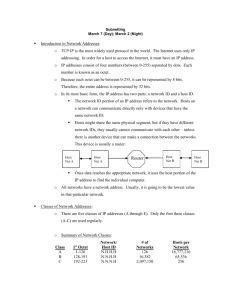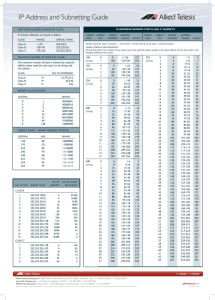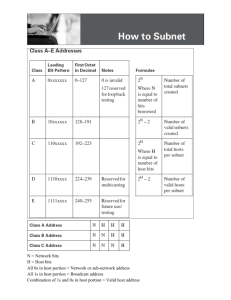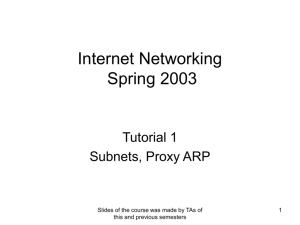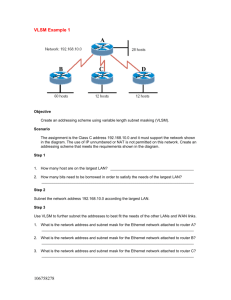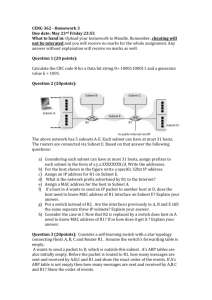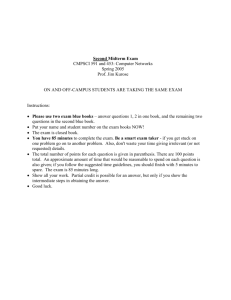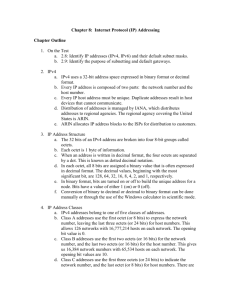IP addresses
advertisement
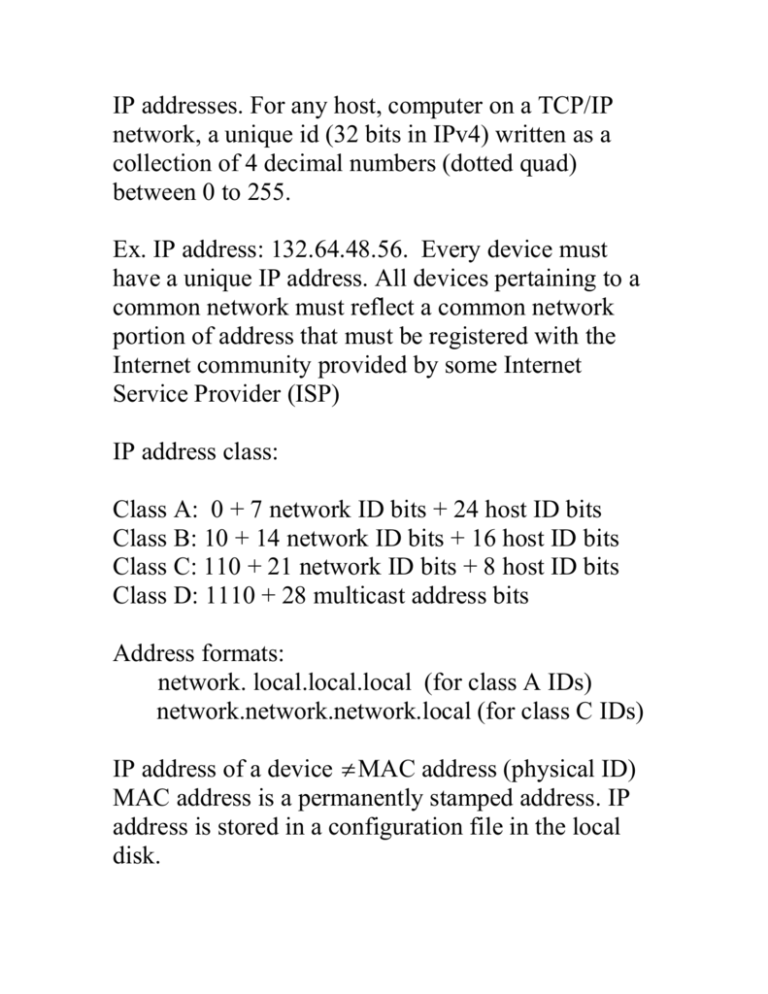
IP addresses. For any host, computer on a TCP/IP network, a unique id (32 bits in IPv4) written as a collection of 4 decimal numbers (dotted quad) between 0 to 255. Ex. IP address: 132.64.48.56. Every device must have a unique IP address. All devices pertaining to a common network must reflect a common network portion of address that must be registered with the Internet community provided by some Internet Service Provider (ISP) IP address class: Class A: 0 + 7 network ID bits + 24 host ID bits Class B: 10 + 14 network ID bits + 16 host ID bits Class C: 110 + 21 network ID bits + 8 host ID bits Class D: 1110 + 28 multicast address bits Address formats: network. local.local.local (for class A IDs) network.network.network.local (for class C IDs) IP address of a device MAC address (physical ID) MAC address is a permanently stamped address. IP address is stored in a configuration file in the local disk. Subnets: A single network may be split into a multiple networks for internal use but appear as a single network to outsider. This is the concept of subnets. Subnet mask. An address such that when added to network address (in bitwise-and) splits the address into network + subnet + host address. e.g. IP address: 12.11.10.9 subnet mask 255.254.0.0 Since the leading bit begins with 0, it’s a Class A network with address 12.0.0.0 00001100 00001011 00001010 00001001 IP + 11111111 11111110 00000000 00000000 Subnet ___________________________________________ 00001100 00001010 | 00000000 00000000 Network is extended by 7 more bits. Therefore, this is subnet 10. The remaining host part is 0.1.10.9 is the host address. IP and subnet masks are often presented together in this format. e.g. Network address = 154.4.32.0 , subnet mask = 255.255.224.0. In this case, the network address can be written as 154.4.32.0/19 indicating subnet has 19 bits for the network portion of address, and has remaining 13 bits for host part. Therefore, total number of subnets = 23 -2 = 6 Total numbe of hosts per subnet = 213 2 8190 Example. Address on a packet is 132.15.47.8. The subnet mask is 255.255.252.0/22. If we AND the two, we get the following: Address: 132.15.0010 1111| 0000 1000 Subnet: 255.255.1111 1100| 0000 0000 Network: 132.15.00101100| 0000 0000 It’s on network 132.15.44.0, on the subnet 3 and it’s for the host numbered 8. Classless Interdomain Routing (CIDR) Classfull addresses waste a lot of addresses. Ideally, we could bunch similar network addresses together and reduce ARP table considerably. Each organization gets a number (variable) of subnets specified by A / m where A is a 32-bit number denoting the address space and m is a number between 1 and 32. In this scheme, the organization receives 2 m nets all sharing the first 32 m bits of A. Example. The network 142.31/16 corresponds to all 216 addresses in the range [142.31.0.0, 142.31,255,255] Another solution. IPv4 is replaced by IPv6 (RFC 1833). http://playground.sun.com/ipv6/INET-IPngPaper.html Basic elements: a. Expanded routing and addressing capability. Instead of 32 bits address, 128 bits address. b. Provides “anycast address” (a set of interfaces, one of which (generally the nearest one) receives packets sent to “anycast address” – for control purpose) c. Lower header cost d. Improved support for options for more efficient forwarding, more flexible option set, … e. Added QoS/Real-time service capabilities f. Support for authentication, data integrity, and confidentiality. g. IPv6 does away with network-layer fragmentation and reassembly. End hosts are expected to perform path-MTU (Maximum Transmission Unit, the packet size). All IPv6 networks must handle an MTU of at least 1280 bytes. CIDR Lookups: Longest Prefix Match (LPM) Example of a LPM to compress a router table. ‘000’ ‘001’ ‘010’ ‘011’ ‘100’ ‘101’ ‘110’ ‘111’ A A A B A B B B 00* 010 011 100 101 11* A A B A B B 0* 011 100 1* A B A B We can compress a router table by using ranges instead of distinct network addresses. Router needs to implement a prefix match to check if the address being looked up falls in the range A / m for each entry in its forwarding table. e.g. Consider the IPv4 routing table below. 148.13.0.0/16 148.13.20.16/28 …… …… Router needs to lookup for an address 148.13.20.19, and both entries in routing table match. Both entries contain the looked up address. In such cases, the longest prefix of the candidate routes is 148.13.20.16/28, since its subnet mask /28 is higher than other entry’s mask /16 making the route more specific. Some distinct networks: a. 127.0.0.0 is used for loop-back address (typically in the form of 127.0.0.1) b. When host address is either all 0s (4.2BSD) or all 1s (Unix OS standard), it’s considered a broadcast message. c. For mobile objects, two addresses: Home address (permanent), and a care-of address. Used only for forwarding IP datagrams and admin functions. Higher layers never use them. d. Care-of addresses two types: Foreign agent address, and Co-located care of address where mails are sent directly to the device on a foreign net. Network Address Translation (NAT) IP addresses are scarce. One solution: Dynamic allocation of addresses by ISPs when its clientsystem is online, take it away when not online and reassign it to another caller. Doesn’t work for systems which are mostly online such as business computers. Also, home users with ADSL connectivity providing Internet over cable. Modem Broadband cable Computer Router Computer Computer With a permanent IP address here! So, how do we handle this when not enough addresses are in store? Solution. A quick-fix short-term solution, NAT (RFC 3022). 1. Each company receives an IP ( or a few) address for Internet traffic. 2. Inside, they are allowed to use private IPs within these ranges: 10.0.0.0 – 10.255.255.255/8 (16,777, 216 hosts) 172.16.0.0 – 172.31. 255.255/12 (1,048,576 hosts) 192.168.0.0 – 192.168.255.255/16 (65,536 hosts) 3. An outgoing traffic would remove the local IP address and insert the assigned address instead. 10.0.10.25 138.67.42.12 Packet NATBox/Fir ewall 4. Since both TCP/UDP end-to-end connections contain the source port & destination port specifications, sender after specifying the source port indicates where to receive incoming packets belonging to this connection. At the same time, it tells which port to dump it on the receiver side. TCP/IP includes a protocol suit ARP (Address Resolution Protocol) to map IP addresses to physical addresses by network administrators. The constructed table is called ARP cache. ARP centers about the address dichotomy (IP address, MAC or device address). Example. Consider the following: A1 A2 A3 A4 A5 A6 R3 R1 E1 R2 E3 E2 Two networks. Served by two routers R1 and R2, and a router R3. A1 wants to send a packet to A3. A3 is known to A1 as a3@sunyit.edu . How is it handled? 1. A1 issues gethost(a3@sunyit.edu) 2. Local DNS (Domain Name System) server picks up the logical address & returns its IPA3 to A1 3. A1 sends a broadcast on the net asking who owns IPA3 . A3 will respond to it sending A1 its machine address. This protocol to find the mapping IP M where M is machine address is called ARP (Address Resolution Protocol, RFC 826). What if A1 wants to send to A6? Using ARP will fail since A6 will not see the broadcast, and routers don’t relay broadcasts. One solution: In the ARP table, make an entry like (other_nets, R1) and send all non-local packets to R1. This is proxy ARP. From R1, the packet goes to R2, if it is on the network indicated. Otherwise, it might go to other router by default. RARP = Reverse Address resolution Protocol permits the inverse mapping from MAC to corresponding IP address. Hosts such as diskless workstations only know their MAC addresses when booted but not their IP addresses. This must be obtained from an RARP server source. (RFC 903 for details).


